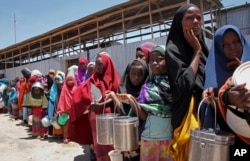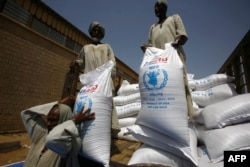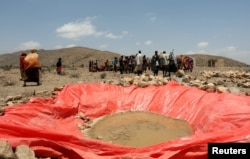VOA’s Salem Solomon appeared on “The Correspondents” program hosted by Mil Arcega to discuss the ongoing food security crisis in Africa. Below are some of Arcega’s questions and Solomon’s answers, along with additional information about this crisis.
What’s the latest news about food insecurity in Africa? Where is the situation getting better, and where is it getting worse?
Answer: There has been promising news coming from Somalia and South Sudan. The Famine Early Warning Systems Network (FEWS NET) — a U.S.-funded body that tracks food insecurity around the world — releases regular reports on affected areas.
One highlight in their most recent update is the effectiveness of early detection of food insecurity and aggressive responses. Airdropping food to restricted places in South Sudan, for example, has helped decrease the death toll that would otherwise have occurred.
However, about 4 million people have been displaced because of conflict in South Sudan, and humanitarian organizations warn that 45,000 people in the two counties in Unity State where famine has been declared, Leer and Mayendit, are still in desperate need of food aid. This is an increase of 25,000 people since just last month.
If assistance doesn’t come, these areas could easily slip back into famine.
A similar phenomenon is occurring in Somalia, where rainfall in May was better than the previous month. Still, the overall rainy season was 30 percent to 60 percent below a typical season, and farmers are struggling to keep crops alive.
Overall, 3.2 million people in Somalia are at risk, 350,000 children are malnourished and 70,000 children are severely malnourished. Famine has been averted for now, but FEWS NET forecasts that much of the country will remain at Phase 4, which is defined as a food security emergency, through September.
In Northeastern Nigeria, it was learned earlier this week that approximately half of the much-needed food aid never reached the victims of Boko Haram who are so badly in need. This occurred because of “diversion,” according to a government statement, which is another way of saying it was likely stolen.
As a result, many of the 8.5 million people who need food assistance after fleeing the extremist group will be unable to get food.
Food prices continue to spike, and the country is entering what’s known as the lean season, which lasts through September. That typically means food hardship increases because the country is between harvests. The good news is that Boko Haram has been severely degraded, and attacks have decreased compared to the past few years.
It’s become common to call these man-made crises. How does conflict exacerbate the food insecurity in these countries? Are terror groups taking advantage of the situation?
Answer: All four of the countries experiencing the most critical food insecurity — Nigeria, South Sudan, Somalia and Yemen — are either at war or under attack by an insurgent group. In this context, both large-scale and subsistence farmers have been forced to flee their land. This harms the countries’ food supplies and makes what food is available that much more expensive. For example, a VOA reporter in Somalia determined that the price of a kilo of tomatoes nearly doubled within the span of one week. In the northeast Nigerian city of Maiduguri, staple food items, such as rice, maize, millet and sorghum, are 50 percent more expensive than they were last year.
Both terror groups and, sadly, government forces in some places have used food and access to food as a weapon of war. In northeast Nigeria, Boko Haram insurgents have occupied farmland, burned crops and destroyed irrigation systems. In South Sudan, government forces have prevented food from reaching rebel strongholds to starve the local population into submission.
Meanwhile, in Somalia, the terror group al-Shabab has, in some cases, distributed food aid to people who are living in areas it controls. They have used this assistance as a way of recruiting young people and winning the hearts and minds of the local population. They want to be seen as the protector and use access to food to bolster this image.
Is the international community doing enough? What about the U.S.? How will budget cuts to foreign aid affect these efforts in Africa and Yemen?
Answer: The short answer is no, the international community is not doing enough. That’s according to the U.N., which said earlier this year that it needs $6.1 billion to avert a hunger crisis in the four affected countries. By the beginning of June, only $2.2 billion had been pledged by international donors.
In the U.S., there has been some good news recently. Nearly $1 billion was added to the 2017 fiscal year omnibus bill in emergency relief for famine. This money will help.
But globally, there is a lot of concern about a perceived shift by the U.S. away from playing a leadership role in international aid.
For example, the Trump administration’s proposed 2018 budget calls for cutting USAID funding by 31 percent and consolidating the program within the State Department. Some published reports have suggested that the budget would eliminate FEWS NET, which is the most important tool available worldwide for monitoring and sounding the alarm when food insecurity is about to occur.
In a hearing last week, the U.S. House Subcommittee on Africa discussed the famine response. Humanitarian groups voiced deep concern over the proposed budget cuts. In particular, Tony P. Hall, executive director emeritus at the Alliance to End Hunger, said he was very worried about the potential cuts.
But Congressman Chris Smith of New Jersey, a Republican who chairs the committee, said he was confident that these cuts will not happen as proposed. He stressed that Congress writes the budget, not the president.
What are the other factors that contribute to food insecurity across the continent? What role do climate change and weather events, such as El Niño and La Niña, play?
Answer: People in each region we’re discussing do not live with a safety net. That’s in the best of times. If a crop fails or a rainy season doesn’t come as expected, they risk starvation.
The effects of climate change have particularly impacted people in the Sahel region of Africa, which stretches from Senegal and Mauritania on the west coast to Ethiopia and Eritrea on the east coast. It has been well documented that the Sahara desert is expanding southward, and bodies of water, such as Lake Chad, are drying up. Countries are witnessing some of the hottest average annual temperatures on record.
On top of this, the El Niño weather pattern event of 2015 and 2016 caused a massive drought in Eastern and Southern Africa. Following that, La Niña, another weather pattern, resulted in worsening drought in some places and flooding in others.
What we’re seeing is people who are living on the edge, as many subsistence farmers in Africa are, being pushed over the edge by these climate events.
What has VOA done so far to report about this crisis? How is the Africa Division covering this issue?
Answer: In launching the “Hunger Across Africa” project, we hoped to provide a comprehensive look at one of the most important stories facing the continent right now. Months ago, we knew we would devote a good number of reporting and editing resources to covering this story. But we wanted to make sure our audience got the big picture along with the incremental coverage that we’d provide through our daily reporting.
We have focused on explaining how food insecurity works based on the work of FEWS NET. We also wanted to provide an easy-to-access archive of coverage. So, we categorized stories by type (for example, root causes and solutions) and by country. And we created an infographic that provides “at-a-glance” details from one country to the next.














